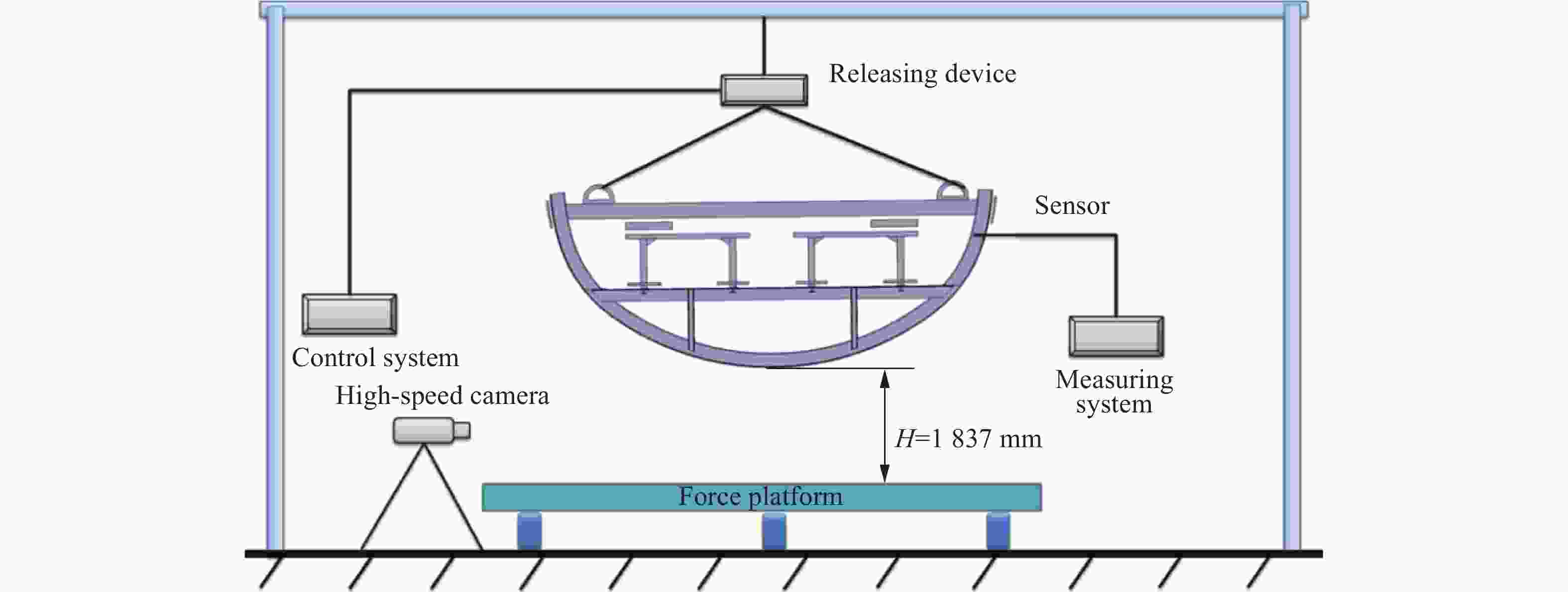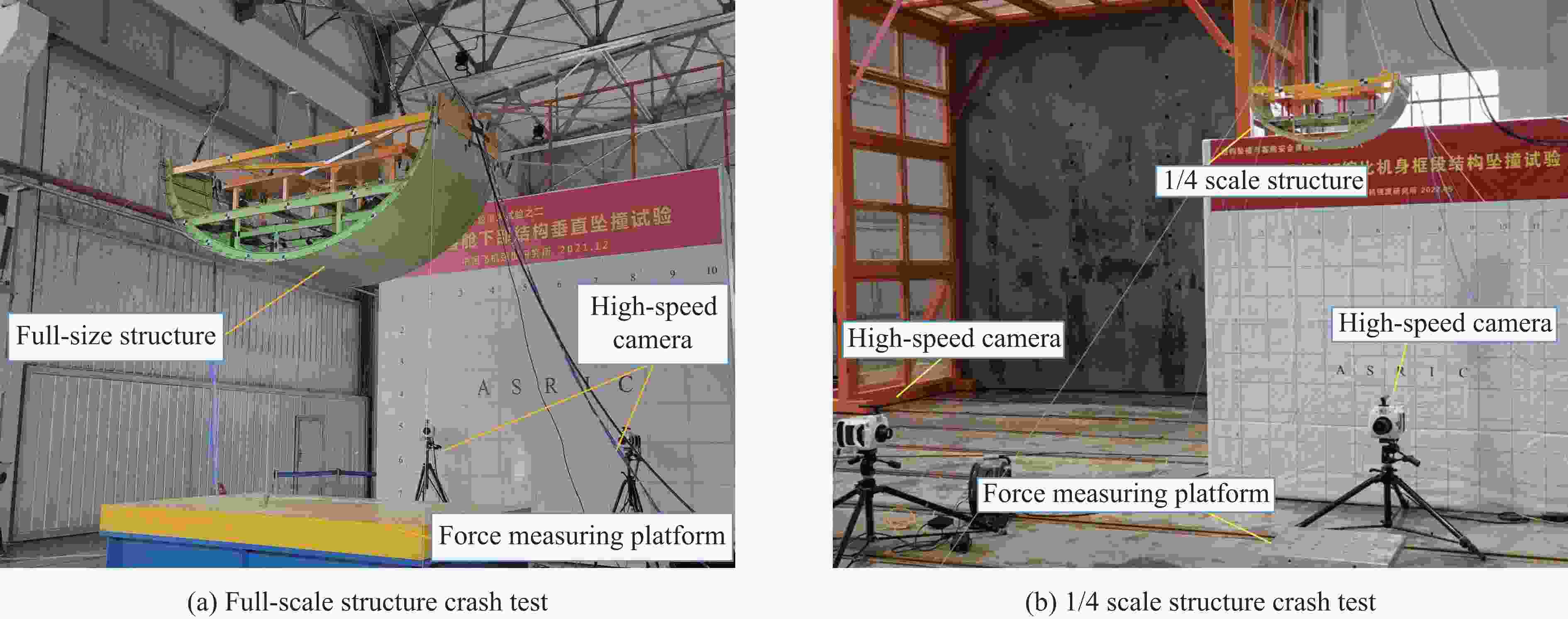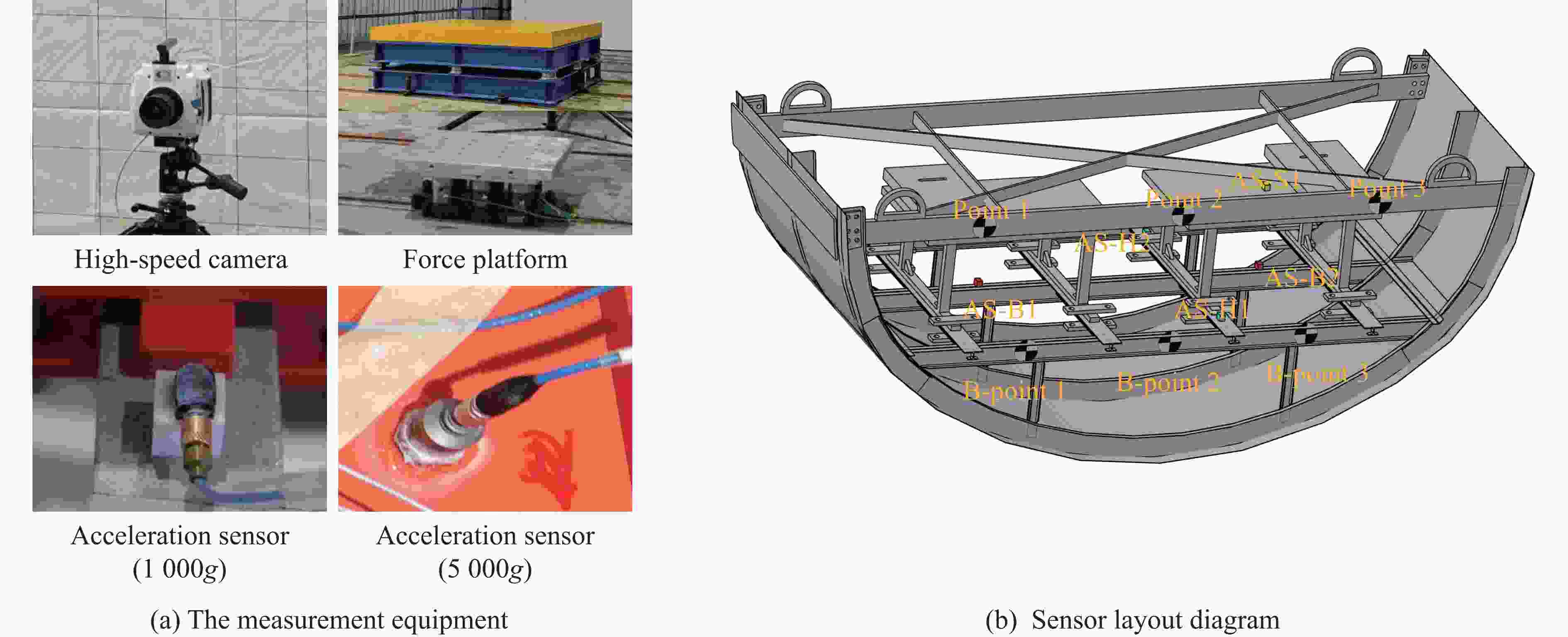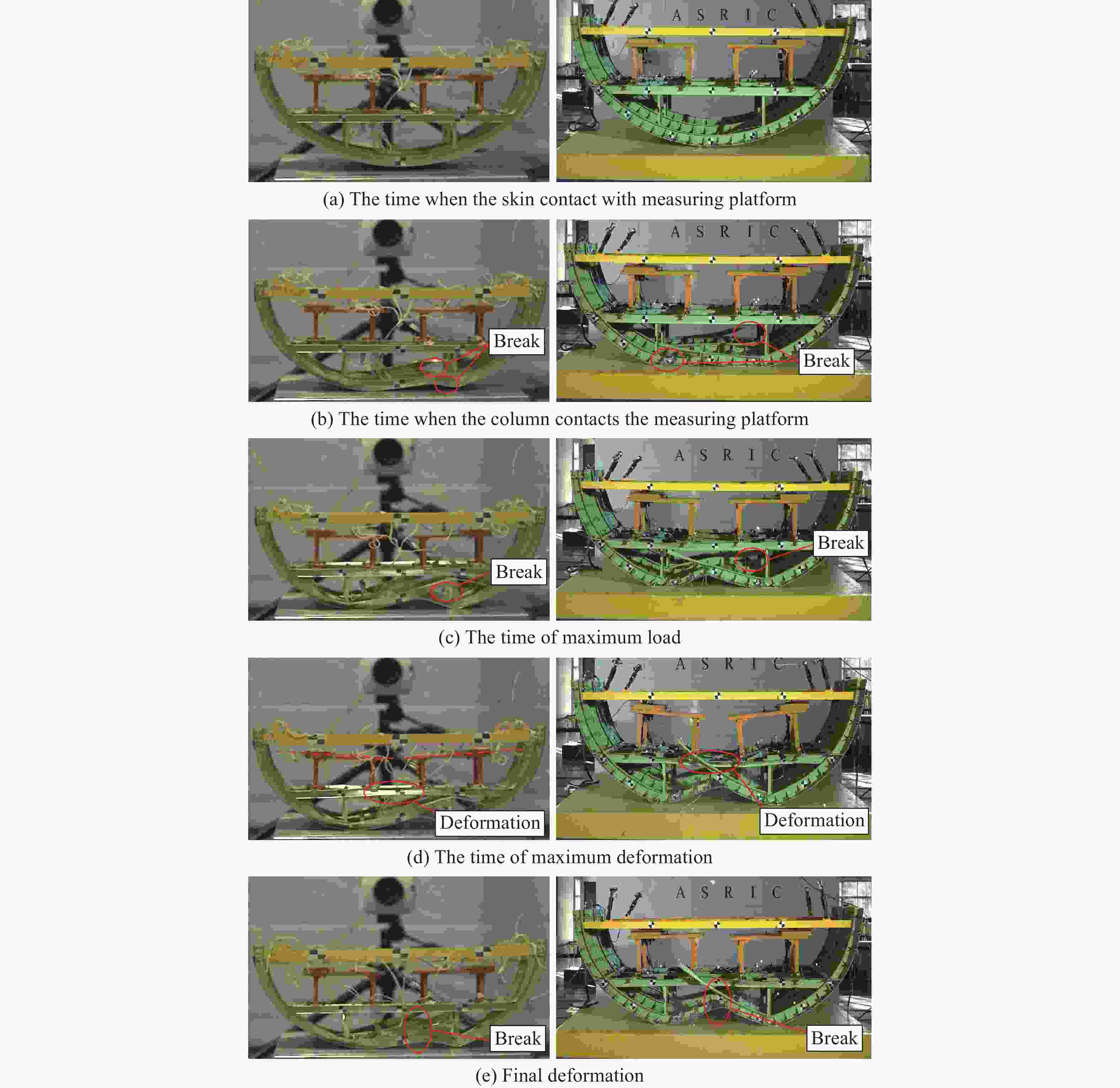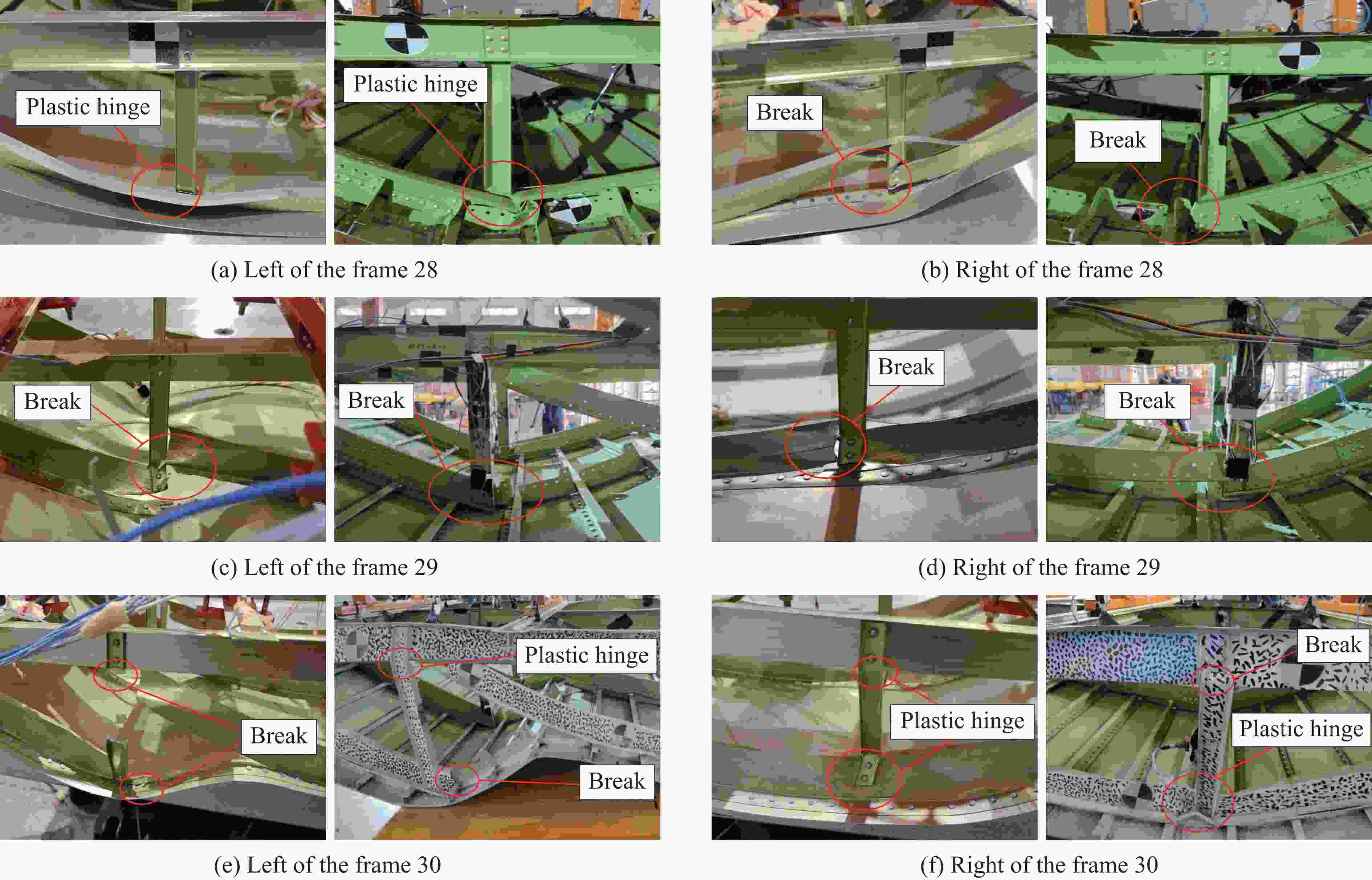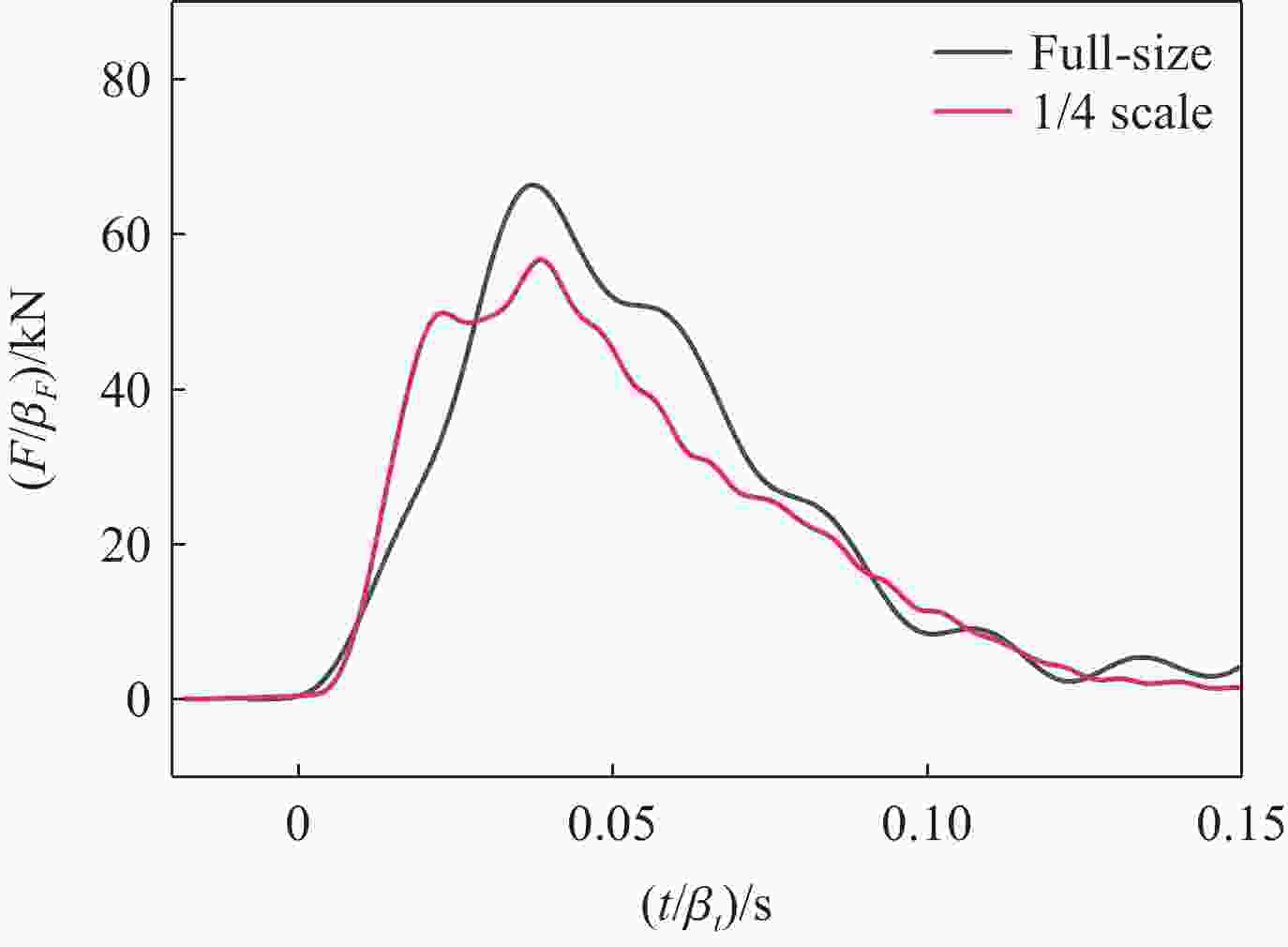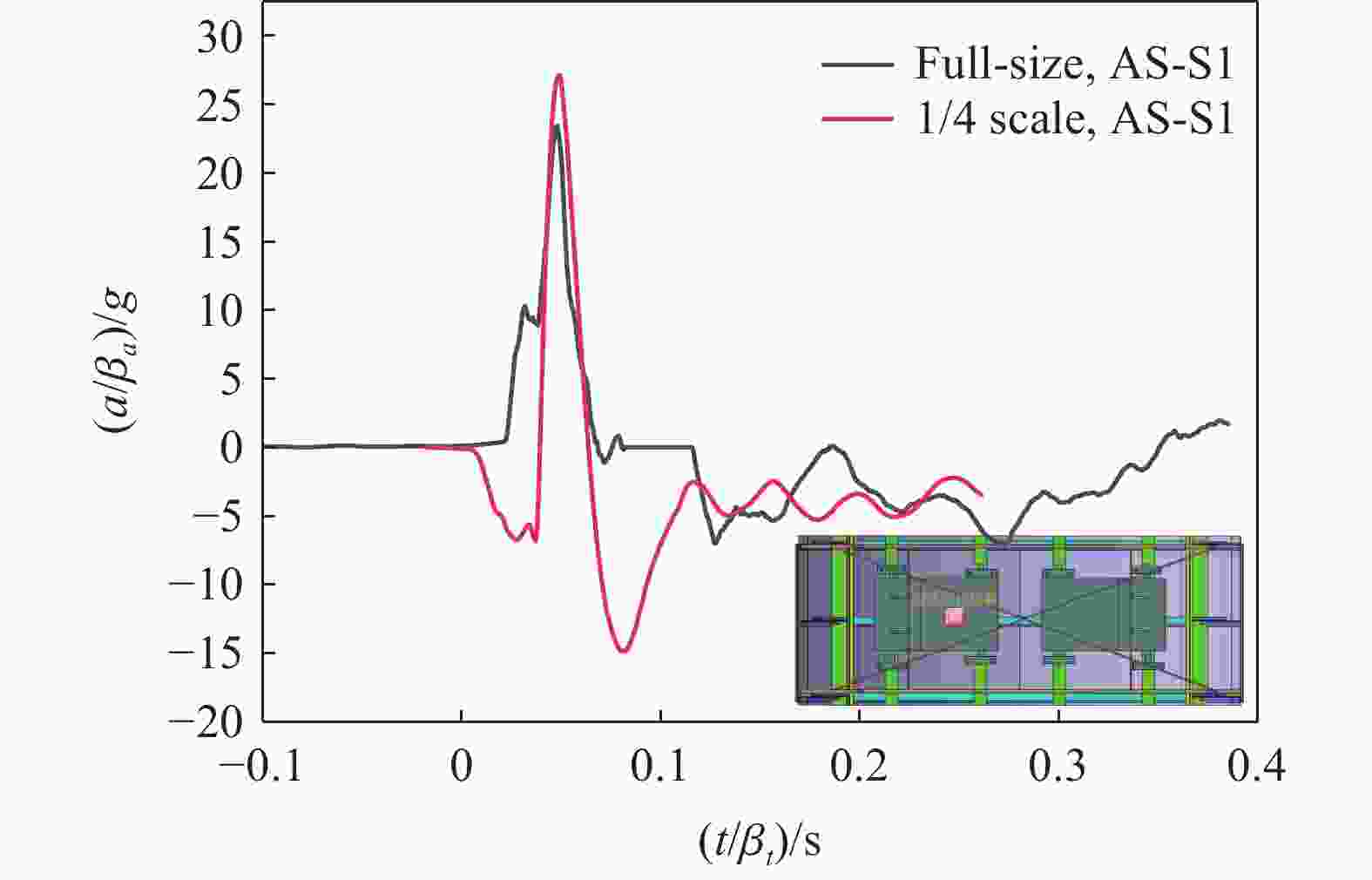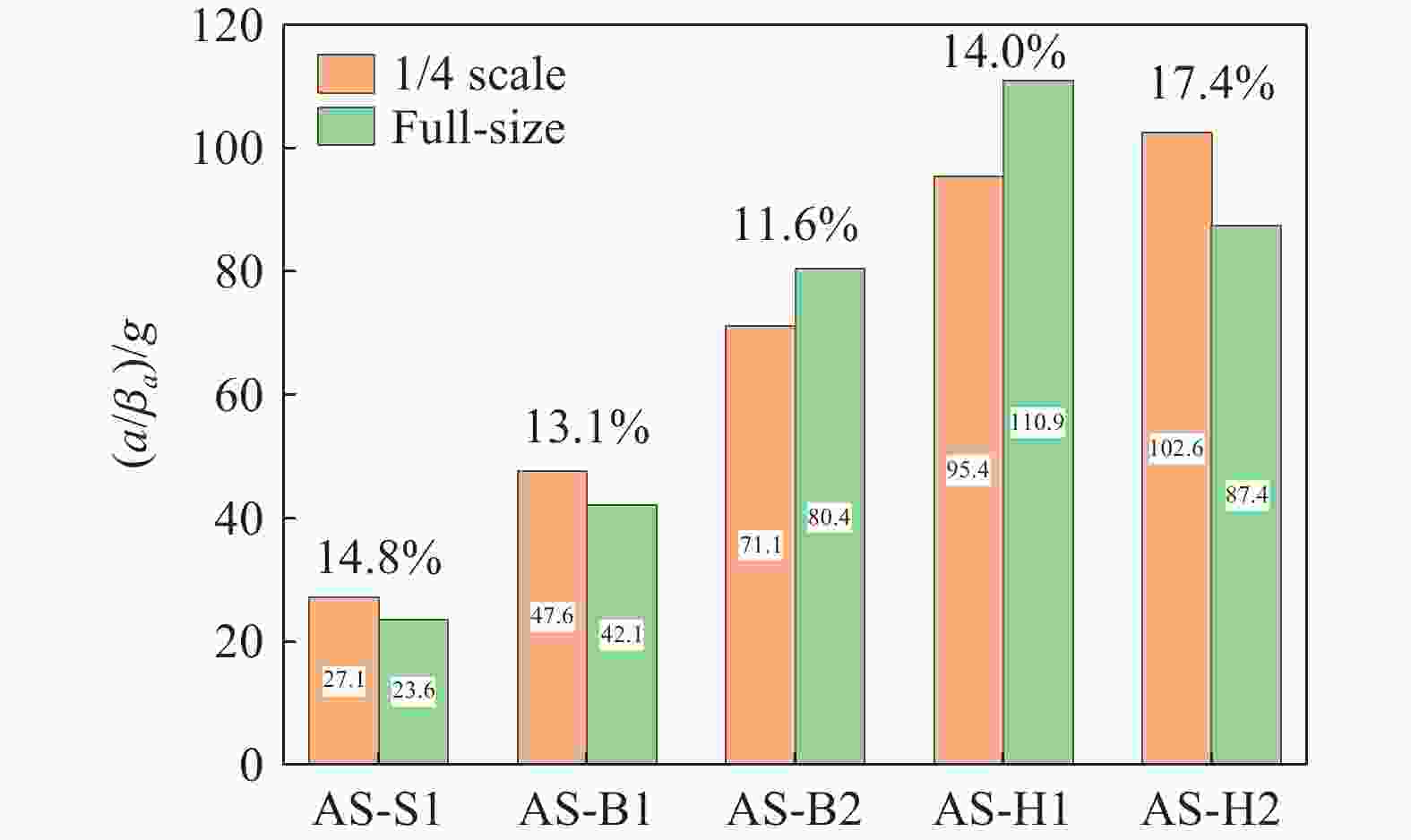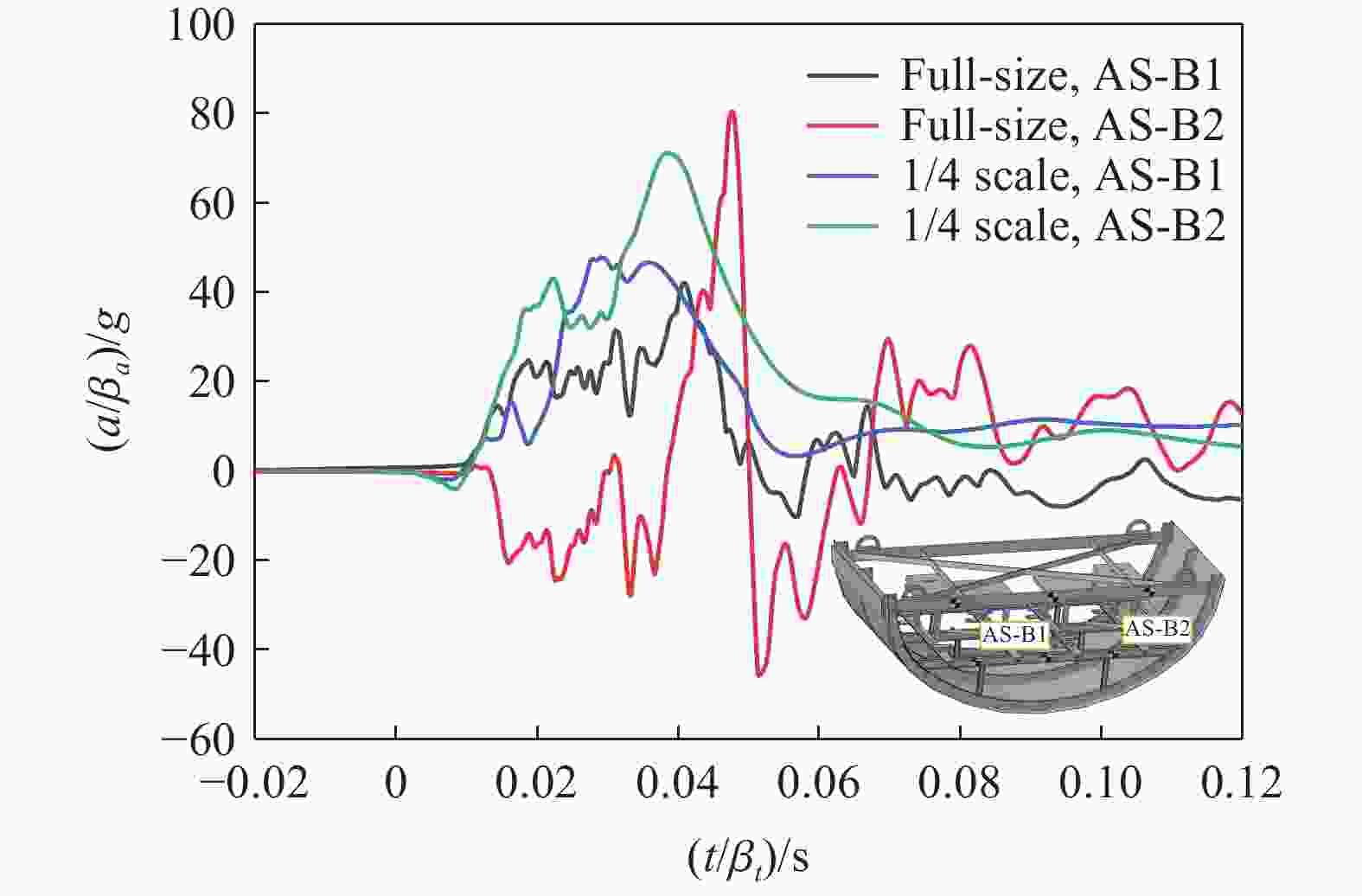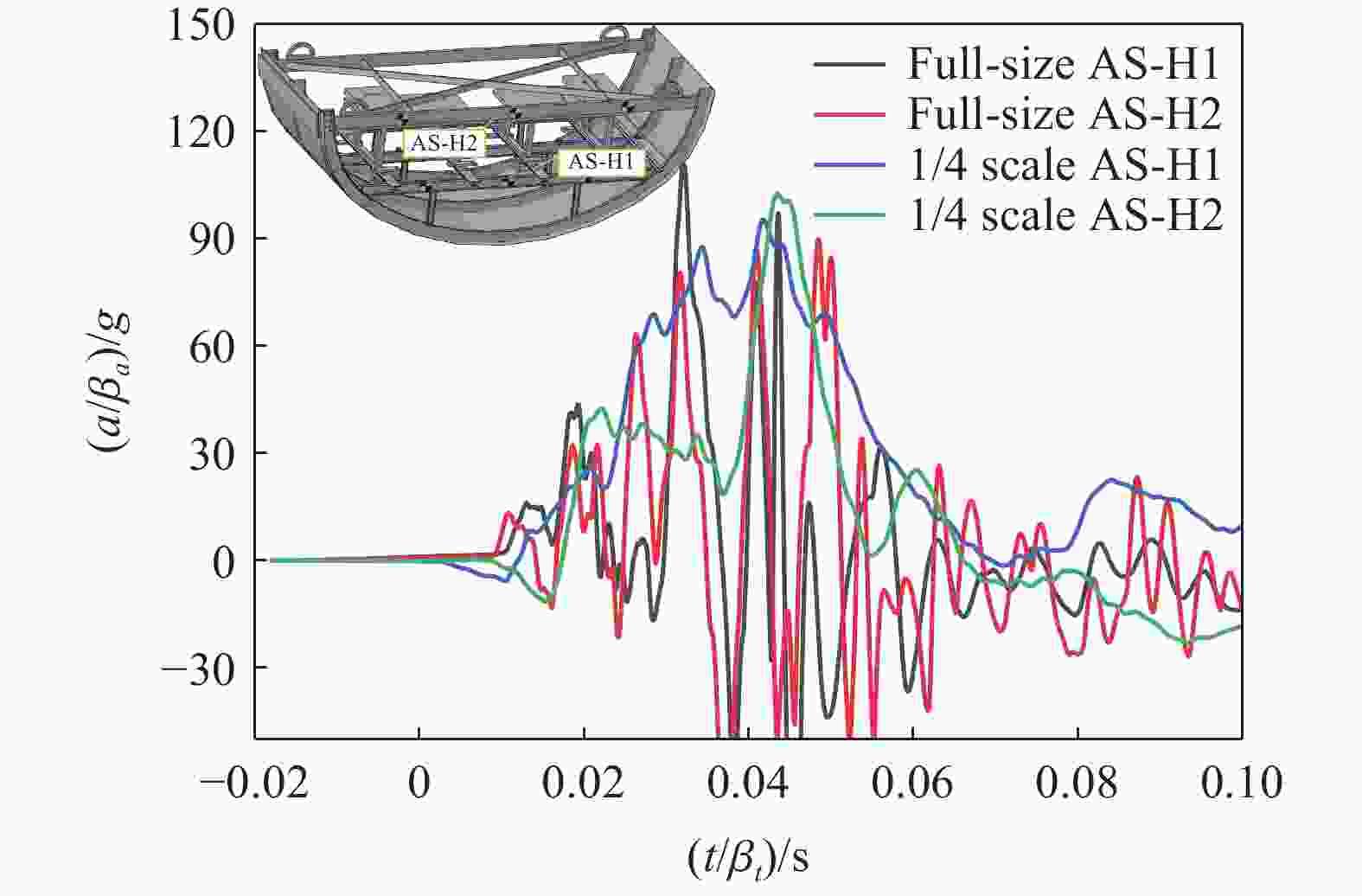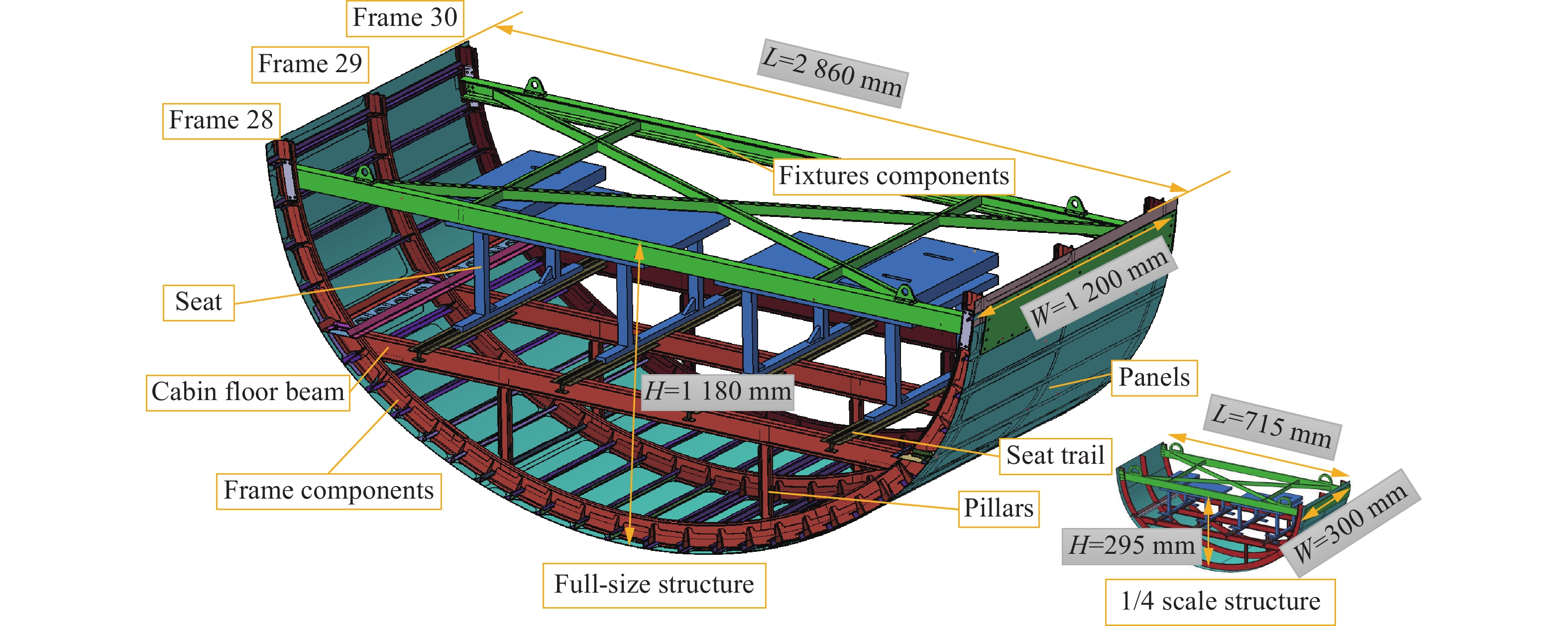Research on scaled experimental method of civil aircraft crash performance
-
摘要: 缩比实验具有成本低、风险小、周期短等优势,在航空航天等领域应用广泛。以典型民机机身下部结构为对象,开展了民机结构坠撞缩比理论分析和实验方法研究。推导了民机坠撞缩放比例因子,设计并加工了1/4缩比实验件,开展了6 m/s工况下的坠撞实验,获得了全尺寸坠撞实验与缩比实验中机身结构关键位置处的速度和加速度响应、地面撞击载荷响应以及局部关键部位的变形和破坏模式,并对其进行了对比分析。结果表明:缩比实验件与全尺寸实验件在框和立柱处的变形和破坏模式具有较好一致性。缩比结构对全尺寸原型结构的坠撞载荷峰值预测误差为14.4%,座椅加速度峰值预测误差为14.8%,横梁处的加速度峰值预测误差为13.1%。缩比实验可以有效预测全尺寸原型结构的变形、破坏过程和关键部位的动态响应,可用于民机结构坠撞性能验证和评估。Abstract: The small-scale test has several advantages, such as low cost, low risk, and short duration, and has been widely applied in aerospace and other fields. Taking the lower structure of a typical civil aircraft fuselage as the research object, this study conducted theoretical analysis and experimental methodology of scaling on the impact crashworthiness of civil aircraft structures. Using a dimensional analysis, the complex dynamics of the fuselage crash were simplified to identify key physical parameters and processes. The main objects, critical physical parameters, and physical processes involved in the aircraft crash were discussed, leading to the extraction of key basic physical parameters and the derivation of primary dimensionless numbers that control the crash response of the fuselage structure. Based on the Buckingham Π theorem, the scaling factor for civil aircraft crashes was derived, establishing the small-scale experimental methodology. A 1/4 scale experimental model was designed and fabricated, and an impact test at a speed of 6 m/s was performed. The velocity, acceleration, ground impact load, deformation, and failure modes of key components in both full-scale and small-scale crash tests were obtained and compared. The applicability and accuracy of the small-scale theory in the crash experiment of the civil aircraft fuselage frame section were verified. The results show that the deformation and failure modes of the frames and columns of the 1/4 scale model are in good agreement with those of the full-scale model. The peak crash load prediction error of the small-scale structure for the full-scale prototype structure is 14.4%, the peak seat acceleration prediction error is 14.8%, and the peak acceleration prediction error at the beam is 13.1%. The small-scale tests can effectively predict the deformation, failure process, and dynamic response of key parts of the full-scale prototype structure. Therefore, the small-scale test could be used to verify and evaluate the crash performance of civil aircraft structures.
-
Key words:
- civil aircraft /
- scaling theory /
- crash performance /
- experimental method
-
表 1 机身结构坠撞实验主要物理量及无量纲数
Table 1. Main physical quantities and dimensionless numbers of fuselage structure crash test
物理量 量纲 无量纲数 物理量 量纲 无量纲数 t $ {\left[t\right]=\rho }^{0}{L}^{1}{v}^{-1} $ $ {\varPi }_{1}=\dfrac{tv}{L} $ ε $ {\left[\varepsilon \right]=\rho }^{0}{L}^{0}{v}^{0} $ $ {\varPi }_{6}=\varepsilon $ δ $ {\left[\delta \right]=\rho }^{0}{L}^{1}{v}^{0} $ $ {\varPi }_{2}=\dfrac{\delta }{L} $ F $ {\left[F\right]=\rho }^{1}{L}^{2}{v}^{2} $ $ {\varPi }_{7}=\dfrac{F}{\rho {L}^{2}{v}^{2}} $ m $ {\left[m\right]=\rho }^{1}{L}^{3}{v}^{0} $ $ {\varPi }_{3}=\dfrac{m}{\rho {L}^{3}} $ En $ {\left[{E}_{\mathrm{n}}\right]=\rho }^{1}{L}^{3}{v}^{2} $ $ {\varPi }_{8}=\dfrac{{E}_{\mathrm{n}}}{\rho {L}^{3}{v}^{2}} $ a $ {\left[a\right]=\rho }^{0}{L}^{-1}{v}^{2} $ $ {\varPi }_{4}=\dfrac{aL}{{v}^{2}} $ $ {\sigma }_{\mathrm{d}} $ $ {\left[{\sigma }_{\mathrm{d}}\right]=\rho }^{1}{L}^{0}{v}^{2} $ $ {\varPi }_{9}=\dfrac{{\sigma }_{\mathrm{d}}}{{\rho v}^{2}} $ $ \sigma $ $ {\left[\sigma \right]=\rho }^{1}{L}^{0}{v}^{2} $ $ {\varPi }_{5}=\dfrac{\sigma }{{\rho v}^{2}} $ E $ {\left[E\right]=\rho }^{1}{L}^{0}{v}^{2} $ $ {\varPi }_{10}=\dfrac{E}{{\rho v}^{2}} $ 表 2 机身结构坠撞缩放比例因子
Table 2. The scaling factor of aircraft structure crash test
物理量 缩放比例因子 物理量 缩放比例因子 物理量 缩放比例因子 $ L $ $ \beta ={L}_{\mathrm{m}}/{L}_{\mathrm{p}} $ $ \sigma $ $ {\beta }_{\sigma }={\beta }_{\rho }{\beta }_{v}^{2} $ a $ {\beta }_{a}={\beta }_{v}^{2}/\beta $ $ \rho $ $ {\beta }_{\mathrm{\rho }}={\rho }_{\mathrm{m}}/{\rho }_{\mathrm{p}} $ $ \varepsilon $ $ {\beta }_{\varepsilon }=1 $ m $ {{\beta }_{m}={\beta }_{\rho }\beta }^{3} $ $ v $ $ {\beta }_{v}={v}_{\mathrm{m}}/{v}_{\mathrm{p}}={({\beta }_{{\sigma }_{\mathrm{d}}}/{\beta }_{\rho })}^{1/2} $ $ F $ $ {{\beta }_{F}={\beta }_{\rho }\beta }^{2}{\beta }_{v}^{2} $ E $ {\beta }_{E}={\beta }_{\rho }{\beta }_{v}^{2} $ $ t $ $ {\beta }_{t}=\beta /{\beta }_{v} $ $ {\sigma }_{\mathrm{d}} $ $ {\beta }_{{\sigma }_{\mathrm{d}}}={\beta }_{\rho }{\beta }_{v}^{2} $ $ {E}_{\mathrm{n}} $ $ {{\beta }_{{E}_{\mathrm{n}}}={\beta }_{\rho }\beta }^{3}{\beta }_{v}^{2} $ $ \delta $ $ {\beta }_{\delta }=\beta $ 表 3 缩比实验件与全尺寸实验件各物理量的缩放比例
Table 3. The scaling ratio of physical quantities between the small-scale and the full-size test
物理量 缩放比例 物理量 缩放比例 物理量 缩放比例 $ L $ $ \beta =1/4 $ $ \sigma $ $ {\beta }_{\sigma }=1 $ a $ {\beta }_{a}=4 $ $ \rho $ $ {\beta }_{\rho }=1 $ $ \varepsilon $ $ {\beta }_{\varepsilon }=1 $ m $ {\beta }_{m}=1/64 $ v $ {\beta }_{v}=1 $ $ F $ $ {\beta }_{F}=1/16 $ E $ {\beta }_{E}=1 $ $ t $ $ {\beta }_{t}=1/4 $ $ {\sigma }_{\mathrm{d}} $ $ {\beta }_{{\sigma }_{\mathrm{d}}}=1 $ $ {E}_{\mathrm{n}} $ $ {\beta }_{{E}_{\mathrm{n}}}=1/64 $ $ \delta $ $ {\beta }_{\delta }=1/4 $ -
[1] 刘小川, 白春玉, 惠旭龙, 等. 民机机身结构耐撞性研究的进展与挑战 [J]. 固体力学学报, 2020, 41(4): 293–323. DOI: 10.19636/j.cnki.cjsm42-1250/o3.2020.035.LIU X C, BAI C Y, XI X L, et al. Progress and challenge of research on crashworthiness of civil airplane fuselage structures [J]. Chinese Journal of Solid Mechanics, 2020, 41(4): 293–323. DOI: 10.19636/j.cnki.cjsm42-1250/o3.2020.035. [2] 牟浩蕾, 谢威威, 解江, 等. 坠撞环境下乘员伤害分析及飞机适坠性评估 [J]. 航空学报, 2024, 45(3): 228786. DOI: 10.7527/S1000-6893.2023.28786.MOU H L, XIE W W, XIE J, et al. Occupant injury analysis and aircraft crashworthiness evaluation under crash scenarios [J]. Acta Aeronautica et Astronautica Sinica, 2024, 45(3): 228786. DOI: 10.7527/S1000-6893.2023.28786. [3] 张欣玥, 惠旭龙, 刘小川, 等. 典型金属民机机身结构坠撞特性试验 [J]. 航空学报, 2022, 43(6): 526234. DOI: 10.7527/S1000-6893.2022.26234.ZHANG X Y, XI X L, LIU X C, et al. Experimental study on crash characteristics of typical metal civil aircraft fuselage structure [J]. Acta Aeronautica et Astronautica Sinica, 2022, 43(6): 526234. DOI: 10.7527/S1000-6893.2022.26234. [4] WILLIAMS M S, HAYDUK R J. Vertical drop test of a transport fuselage section located forward of the wing: 19840002543 [R]. Washington: NASA, 1983. [5] LITTELL J D. A summary of results from two full-scale fokker F28 fuselage section drop tests: 20180004391 [R]. Washington: NASA, 2018. [6] 刘小川, 惠旭龙, 张欣玥, 等. 典型民用飞机全机坠撞实验研究 [J]. 航空学报, 2024, 45(5): 529664. DOI: 10.7527/S1000-6893.2023.29664.LIU X C, XI X L, ZHANG X Y, et al. Full-scale crash experimental study of typical civil aircraft [J]. Acta Aeronautica et Astronautica Sinica, 2024, 45(5): 529664. DOI: 10.7527/S1000-6893.2023.29664. [7] 杨磊峰, 常新哲, 徐绯, 等. 受轴向冲击薄壁圆管的几何畸变相似律研究 [J]. 爆炸与冲击, 2022, 42(5): 053205. DOI: 10.11883/bzycj-2021-0452.YANG L F, CHANG X Z, XU F, et al. Study on the scaling law of geometrically-distorted thin-walled cylindrical shells subjected to axial impact [J]. Explosion and Shock Waves, 2022, 42(5): 053205. DOI: 10.11883/bzycj-2021-0452. [8] 李肖成, 徐绯, 杨磊峰, 等. 薄板在冲击载荷下线弹性理想塑性响应的相似性研究 [J]. 爆炸与冲击, 2021, 41(11): 113103. DOI: 10.11883/bzycj-2020-0374.LI X C, XU F, YANG L F, et al. Study on the similarity of elasticity and ideal plasticity response of thin plate under impact loading [J]. Explosion and Shock Waves, 2021, 41(11): 113103. DOI: 10.11883/bzycj-2020-0374. [9] 王帅, 徐绯, 代震, 等. 结构冲击畸变问题的直接相似方法研究 [J]. 力学学报, 2020, 52(3): 774–786. DOI: 10.6052/0459-1879-19-327.WANG S, XU F, DAI Z, et al. A direct scaling method for the distortion problems of structural impact [J]. Chinese Journal of Theoretical and Applied Mechanics, 2020, 52(3): 774–786. DOI: 10.6052/0459-1879-19-327. [10] WANG S, XU F, ZHANG X Y, et al. Material similarity of scaled models [J]. International Journal of Impact Engineering, 2021, 156: 103951. DOI: 10.1016/j.ijimpeng.2021.103951. [11] CASABURO A, PETRONE G, FRANCO F, et al. A review of similitude methods for structural engineering [J]. Applied Mechanics Reviews, 2019, 71(3): 030802. DOI: 10.1115/1.4043787. [12] 秦健, 张振华. 原型和模型不同材料时加筋板冲击动态响应的相似预报方法 [J]. 爆炸与冲击, 2010, 30(5): 511–516. DOI: 10.11883/1001-1455(2010)05-0511-06.QIN J, ZHANG Z H. A scaling method for predicting dynamic responses of stiffened plates made of materials different from experimental models [J]. Explosion and Shock Waves, 2010, 30(5): 511–516. DOI: 10.11883/1001-1455(2010)05-0511-06. [13] 王悦鑫, 何欢, 吴添, 等. 基于损失函数的缩比模型冲击响应预报结果修正方法 [J]. 航空学报, 2022, 43(8): 225781. DOI: 10.7527/S1000-6893.2021.25781.WANG Y X, HE H, WU T, et al. Modified method for impact response prediction of scaled model based on loss function [J]. Acta Aeronautica et Astronautica Sinica, 2022, 43(8): 225781. DOI: 10.7527/S1000-6893.2021.25781. [14] COUTINHO C P, BAPTISTA A J, RODRIGUES J D. Reduced scale models based on similitude theory: a review up to 2015 [J]. Engineering Structures, 2016, 119: 81–94. DOI: 10.1016/j.engstruct.2016.04.016. [15] OSHIRO R E, CALLE M A G, MAZZARIOL L M, et al. Experimental study of collision in scaled naval structures [J]. International Journal of Impact Engineering, 2017, 110: 149–161. DOI: 10.1016/j.ijimpeng.2017.01.024. [16] HORTA L G. A historical perspective on dynamics testing at the Langley Research Center [R]. Hampton: Langley Research Center, 2000. [17] 殷文骏, 程帅, 刘文祥, 等. 远场爆炸冲击波作用下高层建筑上部结构动态响应试验研究 [J]. 兵工学报, 2024, 45(11): 4039–4051. DOI: 10.12382/bgxb.2023.0960.YIN W J, CHENG S, LIU W X, et al. Experimental study on dynamic response of upper structure of high-rise building under far-field explosion shock wave loading [J]. Acta Armamentarii, 2024, 45(11): 4039–4051. DOI: 10.12382/bgxb.2023.0960. [18] CALLE M A G, OSHIRO R E, ALVES M. Ship collision and grounding: scaled experiments and numerical analysis [J]. International Journal of Impact Engineering, 2017, 103: 195–210. DOI: 10.1016/j.ijimpeng.2017.01.021. [19] 陈暘, 陈立霞, 汪正中. 直升机缩比模型水中横向稳性试验研究 [J]. 直升机技术, 2019(4): 57–59, 72. DOI: 10.3969/j.issn.1673-1220.2019.04.013.CHEN Y, CHEN L X, WANG Z Z. Experiment research on the helicopter scale model lateral stability in water [J]. Helicopter Technique, 2019(4): 57–59, 72. DOI: 10.3969/j.issn.1673-1220.2019.04.013. [20] 金鑫, 刘宇, 唐长红, 等. 舰载机缩比落震动载荷预计及试验技术 [J]. 力学与实践, 2021, 43(4): 521–528. DOI: 10.6052/1000-0879-20-472.JIN X, LIU Y, TANG C H, et al. Prediction and testing technology of vibration load for scaled-model of carrier based aircraft [J]. Mechanics in Engineering, 2021, 43(4): 521–528. DOI: 10.6052/1000-0879-20-472. -






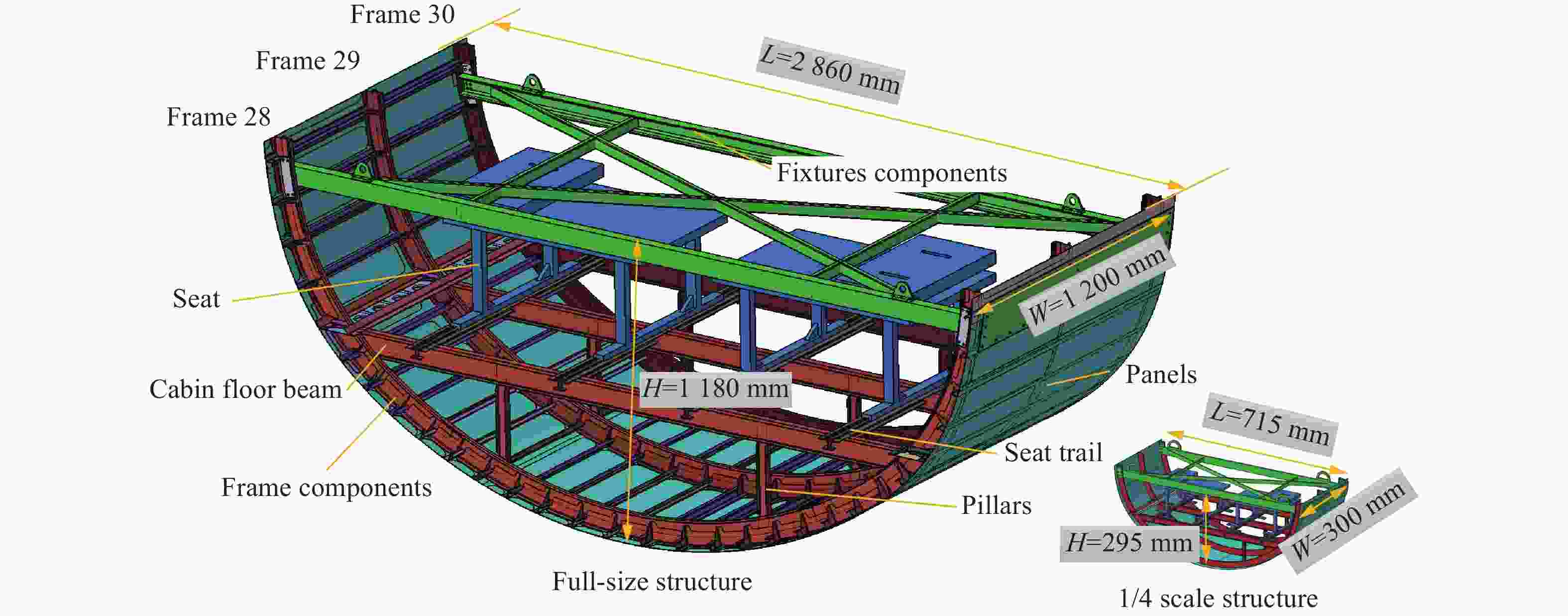
 下载:
下载:
